|
 Mycena parsonsii Mycena parsonsii
SynonymsGalactopus parsonsii
BiostatusPresent in region - Indigenous. Endemic
Images (click to enlarge)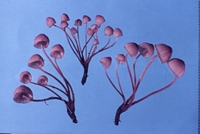
Owner: Herb. PDD | 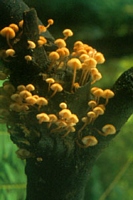
Caption: Mycena parsonii
Owner: Kaimai Bush | 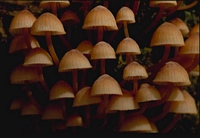
Owner: P.K. Buchanan |  | 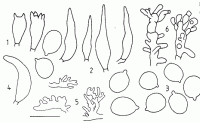
Caption: Fig. 9 M. parsonsii. 1. basidia. 2. cheilocystidia. 3. basidiospores. 4. pleurocystidium. 5. pileipellis elements. 6. terminal cells of stipe. | 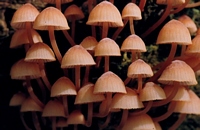
Owner: Peter Buchanan |
Article: Horak, E. (1971). A contribution towards the revision of the Agaricales (Fungi) from New Zealand. New Zealand Journal of Botany 9(3): 403-462 (http://www.rsnz.org/publish/abstracts.php).
Notes: Mycena parsonsii Stevenson (29 D) = Galactopus parsonsii (Stevenson) comb.
nov. (Basionym: M. parsonsii Stevenson, Kew Bull. 19: 56, 1964)
Article: Segedin, B.P. (1991). Studies in the Agaricales of New Zealand: some Mycena species in sections Longisetae, Polyadelpha, Rubromarginatae, Galactopoda, Lactipedes, and Calodontes. New Zealand Journal of Botany 29(1): 43-62 (http://www.rsnz.org/publish/abstracts.php).
Description: Microscopic characters of the holotype
Spores 6.5-9 X 5.5-7 (7.3 X 6.4) µm., Q=1.1, almost
spherical, variable in size but falling very nearly into two groups, approximately
7 X 6.2 and 8.5 X 7 µm. (which probably reflect the presence of the 2- and 4-spored
basidia), smooth, very strongly amyloid. Basidia very short and fat, 15 X 10
µm., 2- and 4- spored. Cheilocystidia abundant, forming a wide band, fusiform-ventricose
to hastate, 35-70 X 6-12 µm., with brownish (in KOH) plasmatic pigment; among
them occasional, irregularly swollen elements with faintly granular contents
which appear to be endings of the latex system. Pleurocystidia 45 X 9 µm., like
the cheilocystidia but shorter and broader and with paler (in KOH) contents.
Trama of thin-walled hyphae, narrow and inflated, colourless except near the
edge of the lamellae, where they may have yellow (in KOH) sap. Pileipellis of
narrow (3-5 µm.) elements with many simple or slightly diverticulate protuberances.
Context of inflated cells, with convoluted, shining yellow (in KOH) lactifers,
7 µm. diam. Cortical cells of the stipe with simple or once-diverticulate outgrowths,
20-30 X 10 µm., singly or in clumps; terminal cells 20-30 X 5) µm., with short
(3-8 µm.) diverticulate protuberances. Clamp connections present.
Description of basidiome based on information from further collections
Pileus very variable
in size from 2-3 mm up to 20mm in diam., broadly conic with a narrow to moderately
broad umbo, or convex, mostly pinkish-fawn (7B5-6) or paler, darker reddish-brown
(8C7) in centre, with very fine, reddish fibrils under a lens, dry, dull, striate-plicate
to more than 1/2 of radius, margin crenulate, often with a deeper pink spot
in the centre of each crenulation; drying vinaceous grey brown (7E6). Lamellae
ascending, adnate with a decurrent tooth to sinuate, flesh pink, drying yellowish-brown
(6B6), fairly broad and somewhat distant, in 2 series, margin Fimbriate, distinctly
red or deep pink or concolorous with the lamellae. (The bright red of the lamellar
edge in some fruiting bodies is due to the bright red sap in the cheilocystidia
and neighboring cells of the trama; in others the sap will be a pale yellow.)
Stipe 5-50 X 1-2 mm, pinkish-fawn lo reddish-brown, darker brown towards the
base and darkening on handling, even, shining, with very fine, pale squamules,
more distinct hairs at the base and attached to the substratum; exuding deep
red latex when broken. Flesh thin red. Smell none, taste unknown. Dried basidiomes
are brown, sometimes with blackened areas depending on age when dried. Stipe
often completely black.
Microscopically,
collections of this fungus are very uniform, easy to identify by the almost
spherical spores (highly variable in size, probably due partly at least to the
presence of 2- and 4-spored basidia) and the broad band of cheilocystidia with
red-brown or yellow sap. Terminal cells 20-30 X 5 µm., with short (3-8 µm.)
diverticulate protuberances were detected on the stipes of many of them (Fig.
9: 6). clamp connections are present occasionally.
Habitat: HABITAT: Gregarious and caespitose on dead wood of Kunzea
ericoides, Leptospermum scoparium, Dacrycarpus dacrydioides
(A. Rich.) Laubenf., Metrosideros excelsa in lowland podocarp Dicotyledonous
forest, on introduced plants such as Quercus robur L. and Cycas revoluta
Thunb. in city gardens, and even in limestone caves.
Notes: This is one of
the most frequently occurring species of Mycena, always in clusters on wood,
commonly on Kunzea, Leptospermum, or Dacrycarpus in mixed
podocarp-dicotyledonous forest, but also in unusual habitats such as on wood
deep in a limestone cave (PDD 55742). The large number of collections indicates
the frequency with which this fungus occurs and the variability in its size
and colouring, and
degree of pigmentation of the lamellar edge. Its habit, in large clusters, always
on dead wood, is distinctive, as is the usually flesh-coloured, striate-plicate
pileus with a darker spot in the centre and crenate margin.
Article: Stevenson, G. (1964). The Agaricales of New Zealand: V. Kew Bulletin 19(1): 1-59.
Description: Pileus 0.1-2 cm diam., testaceous, paler and striate at margin, hemispherical; flesh thin, fawn. Gills decurrent by a tooth, dull pinkish fawn, moderately distant, deep, long and short intercalated. Stipe 2-5 cm x 1-2 mm, ochraceous fawn above, testaceous below, hollow, translucent, fragile. Spores 7 x 8 to 9 x 10 µm, amyloid, thin-availed. Cheilocystidia 40-50 x 5-10 µm, more or less awl-shaped (Fig. 57).
Habitat: In clusters on fallen log, 0tari, 7.6.1958, Stevenson (type).
Notes: Named after Mr. Ivor Parsons, for many years President of the Levin Native Flora Club.
|